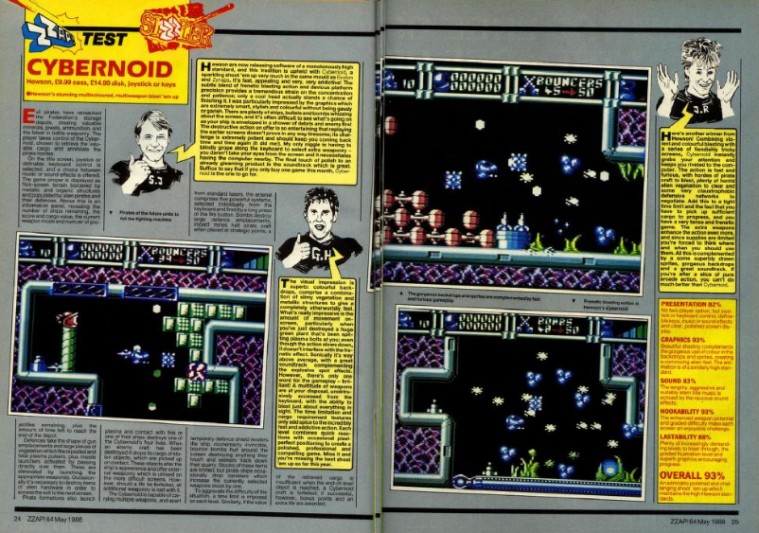The Commodore magazine story: ZZAP! 64 (1985 – 1992)
The history of ZZAP! 64, the 80s British C64 computer magazine which changed the world.
Commodore Format magazine fan site
The history of ZZAP! 64, the 80s British C64 computer magazine which changed the world.
CF might well have trounced everything from 1990 onwards, but the C64 was around for a long time before that and plenty of mags had a crack at writing about it. In part one of our Commodore Magazine Story series, we look at one of the greatest games magazines of all time.

In the mid 2000s, games industry veteran and former ZZAP! 64 reviewer Gary Penn pondered that, perhaps, the Ludlow-based mag was as important to British popular culture in the ’80s as NME or Melody Maker was in the ’70s. He was right: nothing has ever beaten ZZAP! in its prime and everything good in games journalism has happened because ZZAP! 64 did.
SOME BACKGROUND
ZZAP! was the baby of Newsfield Publications. They started out in 1983 as a mail order service for games, but sent out the first monthly catalogue – Crash Micro Games Action – in 1984. It featured the now world-famous Oli Frey artwork as well as games reviews, and quickly caught the attention of a magazine distributor with links to British newsagent chain WH Smith. “They told us if there was a magazine like that, they would probably buy it”, remembers Newsfield co-founder Roger Kean. “So they said if we want to go ahead, we’ve earned the right to lose a lot of money!”
The resulting magazine was Speccy title Crash. Famously, those early issues didn’t employ full-time reviewers. Crash was edited by Roger Kean and he thought that if 14-year-old boys were playing and buying computer games, then that’s exactly who should be reviewing them. So, after spreading the word at a Ludlow school, Newsfield’s offices were full of kids after home time playing the latest games. They’d fill in forms about what they thought, and Roger would type everything up. Crash‘s brutally honest reviews were powerful (“they could make or break a software house”, says early Newsfield employee Matthew Uffindell), creating that all important trust between reader and magazine. Crash looked like a cool comic book, too, with staggering Oli Frey artwork on the cover every month. It proved irresistible and shifted over 100,000 copies a month at its peak.
ENTER ZZAP!
By early 1985, it was obvious that the powerful, brash, American Commodore 64 was a serious player in the computer world. Newsfield wanted to do a magazine for it, so lured Chris Anderson from Personal Computer Games and gave him a budget. Early ideas for a title included Sprite & Sound and Bang – which would have left Wallop for a third, presumably Amstrad CPC, mag.

Common sense prevailed. Or, rather, Chris didn’t like the idea of editing a mag called Bang. ZZAP! 64 was decided upon and the first issue arrived on April 11, 1985. Unlike Crash, Anderson elected to staff his new C64 magazine with three permanent reviewers. Julian Rignall was a national game playing champion and held world record high scores for Defender and Pole Position. He claimed to have switched schools in order to be nearer to his favourite arcade; in the Newsfield interview, Chris asked him about his favourite C64 games. He didn’t own one, so spoke about the Atari games he knew were also on the Commodore. Bob Wade, meanwhile, followed Chris from PCG (which, shortly after Anderson’s departure, closed) and Gary Penn had dazzled Chris with a review he’d sent into a competition held in Personal Computer Gamer.
Chris wanted ZZAP! 64 to have ten things a computer magazine hadn’t had before. They included the cartoon faces on every review so you could see straight away what the verdict was, and a review system incorporating things like hookability and lastability. Anderson loved crazy ratings systems: later, at Future Publishing, he’d delighted in scoring games out of 1000 on ACE.
Innovations aside, though, ZZAP! was successful and is remembered for its incredible personalities. Rignall, Wade and Penn were games junkies before they were journalists and they set the pages of ZZAP! 64 alight. All three would review the big games, and if any were bad, they’d kick the shit out of it. They could and did put publishers out of business.
It almost didn’t make it that far, though. After just twelve weeks, Newsfield’s owners reneged on a deal that had let Chris set up office remotely in Yeovil. They wanted to take full control of Zzap! at Ludlow HQ. ”I objected, and was fired”, Anderson told a 2005 Zzap! special. “But it was the best thing that happened to me, because it spurred me to start Future Publishing”. Bob Wade went off with Chris to make history that we’ll return to later.

In Ludlow, Julian and Gary joined the rest of Newsfield. Roger took the editor’s chair, and ZZAP! carried on selling by the lorry load. Over the years it gave countless games journalists their break, including Commodore Format editor Steve Jarratt and his CF deputy, Sean Masterson. Sean told us what it was like to be young and working on an exciting thing like a games magazine in a sleepy Shropshire town:
“Let me give you an idea of how stupefyingly frustrating I found life in Ludlow. I once intrigued my colleagues on Crash and Zzap! 64 by telling them about Illuminati, by Steve Jackson Games. One night, I brought the game down the pub to play with a few of the guys. It was a quiet night even by the standards of Ludlow. We were almost the only people in the pub. After playing for about half an hour, the landlord, who knew us well, came over and asked us to pack up the game. When I asked why, he was very apologetic but explained that the only other customer in the pub also happened to be an off-duty police officer who suspected that we were gambling. That was Ludlow.”
“But that also meant we spent more time on the magazines. And you’re right; Zzap! 64 and Crash were trailblazers. I think their iconoclastic style did influence us at Future, though you have to consider Chris Anderson’s role in that. Newsfield shone brilliantly for a few years, but it did lose its way after the phenomenal success of those first seminal titles.”
Indeed, by late 1988 Newsfield made the mistake from which ZZAP! would never recover: they began to cover the Amiga. But why? Editor of the time Gordon Houghton – who’d also go on to write for Commodore Format – explains. “It was because we felt the C64 reviews were running dry, but the Amiga wasn’t yet established enough to have its own magazine. We hoped that ZZAP! C64/Amiga would eventually spawn two separate mags, for the C64 and Amiga.”
In fact, this decision left the goal wide open for Chris Anderson’s new business, Future Publishing. There was now no longer a good, dedicated Commodore 64 magazine to buy every month but there were lots of C64 owners who wanted to read one. With Commodore User and now ZZAP! covering the Amiga, a weak Your Commodore was the only C64 exclusive mag out there. Future made their move. In October 1990 Commodore Format launched with ex ZZAP!-ers Steve Jarratt, Sean Masterson, Kati Hamza and Gordon Houghton. By Christmas, it was beating ZZAP!‘s circulation. By the Spring of 1991, it had sent the Ludlow innovators into retreat. ZZAP! relaunched minus the Amiga games. That wasn’t to be the most dramatic event of the year, though. The magazine didn’t appear at all in November 1992 after Newsfield declared bankruptcy. A report to the creditors at the time is pretty straightforward: it notes that Newsfield had incredible success with both Crash and ZZAP! but wasn’t able to replicate that success with titles for newer systems. Money had also been lost on lifestyle magazine LM. It was the end.

Except it wasn’t. ZZAP! was back in time for Christmas under the EuroPress Impact banner, a new company launched by founder Roger Kean and Oli Frey along with Julian Rignall’s brother, Jonathan. Things seemed fine: ZZAP! was glossier and chirpier than ever, and the monthly games cassette could sometimes be to die for. Issue 81, for example, had a Creatures 2 review exclusive and the Andrew Braybrook blockbuster Gribbly’s Day Out on the tape. But a change in editor at issue 82 saw ZZAP! spin out in bizarre fashion. Lucy Hickman filled the magazine with smutty jokes and a character called Miss Whiplash who controversially replaced long-term letters page character Lloyd Mangram; things were eventually toned down with final editor Steve Shields at the helm, but the damage was done. Some parents now refused to let their kids look at ZZAP!. “She wasn’t a bad sort”, remembers ZZAP!‘s James Price of Lucy. “she just didn’t really understand the games mag trade.”
The last issue of ZZAP! 64 was in November 1992. It wasn’t technically the end: it was rebranded as Commodore Force and would soldier on until early 1993. But that’s a story for our next installment (read it here – Ed), and one with twists and turns of its own.
LEGACY
It was ZZAP! which really popularised the magazine team as a set of personalities living a soap opera between the pages, and practically every other games title in the ’80s and ’90s followed suit. Some of this, of course, is Chris Anderson and then Julian Rignall taking their own ideas off to new titles (look at Julian’s Mean Machines for EMAP and see if you can spot the ZZAP! influences, for example) – but nowhere was it ever quite as special as ZZAP!. You weren’t just buying a guide to games; you were entering a world.
ZZAP! 64 at its peak probably hasn’t ever been beaten. It wasn’t just the swagger of the writing, or the legendary illustration. A small business in rural Ludlow staffed by people in their teens and twenties took on the stuffy computer press of London and won. When Commodore User called ZZAP! a “fluffy lollipop” magazine, ZZAP! responded with a Leaderboard cover featuring a gorgeous girl sucking an ice pop. They were the mag and they knew it. And the sheer power of the reviews has become blatant in more recent years, with programmers saying they’d approached the guys in Ludlow with code to see how it could be improved. Uridium, you may like to know, has “anti Julian Rignall” code in it. When he started to beat the game, Andrew Braybrook figured out how top stop him.
Newsfield and ZZAP! were a big deal for Ludlow, too. The sleepy, pretty town with a population of 11,000 ruled the games world – for a while. Today, a blue plaque is on the wall of the building where it all used to happen.

There have been two new ZZAP! issues in the 2000s: issue 107 was made by fans and overseen by ex-editor Gordon Houghton in 2002. A tribute, the Def Guide, came free with Retro Gamer in 2005 (see it here). There was a ZZAP! 2019 annual which was so acclaimed another one arrived in 2020. The original Newsfield owners were involved. They wanted to raise £20,000 to make it happen: to date, both annuals raised over five times that. Not bad for a fluffy lollipop magazine. CF
Since this article was written in 2018, ZZAP! founders Roger Kean and Oli Frey have sadly died. Fusion Retro Publications are publishing the magazine again on a bi-monthly basis. The annuals keep coming too. Hooray!
You must be logged in to post a comment.